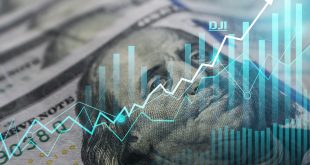Britain’s economy contracted in the three months to September at the start of what is likely to be a prolonged recession, adding to the challenges facing Chancellor Jeremy Hunt as he prepares to raise taxes and cut spending.
Official data on Friday showed Britain’s economy shrank 0.2 percent in the third quarter, less than analysts’ expectations in a Reuters poll of 0.5 percent.
This is the first drop in GDP since the beginning of 2021 when Britain imposed severe restrictions to combat Covid-19. It comes at a time when families and businesses face a severe cost-of-living crisis.
The size of British economy has become much smaller than it was before the pandemic, and it is the only economy within the Group of Seven that has not fully recovered from the recession it caused.
The Resolution Foundation said that although the decline was less than investors had feared, it put Britain on track for the fastest return to recession since the mid-1970s.
Commenting on Friday’s data, Hunt reiterated his warnings that tough decisions on taxes and spending are needed.
The Bank of England said last week that the British economy would enter a two-year recession if interest rates rose as much as investors expect.
He noted that even without further rate hikes, the economy will contract in five of the six quarters until the end of 2023.
The Office for National Statistics said that in September alone, when many businesses closed after declaring a one-day public holiday at Queen Elizabeth’s funeral, the economy shrank 0.6 percent. This exceeds expectations in a Reuters poll of a 0.4 percent contraction and is the largest since January 2021, when there was a shutdown due to Covid-19.
But GDP data in August was revised to show a slight contraction of 0.1 percent, compared to a contraction of 0.3 percent in the base reading.
July’s data was also revised to show GDP growth of 0.3 percent, compared to a previous estimate of 0.1.
The US Bureau of Labor Statistics reported on Thursday that inflation in the US, as measured by the Consumer Price Index (CPI), declined to 7.7% on a yearly basis in October from 8% in September. This reading came in below the market forecast of 8%.
The Core CPI, which excludes volatile food and energy prices, fell to 6.3% from 6.6% on a yearly basis, compared to analysts’ expectations of 6.5%.
On a monthly basis, the CPI and the Core CPI arrived at 0.4% and 0.3%, respectively, with both of these readings falling short of experts’ projections.
Wall Street
The Standard & Poor’s 500 and Nasdaq ended sharply higher on Friday, posting gains for a second consecutive day after a weak inflation reading raised hopes that the US Federal Reserve will become less hawkish in raising interest rates.
Amazon shares jumped 4.3 percent, with Apple and Microsoft rising more than one percent, contributing to Nasdaq’s gains.
The Standard & Poor’s 500 index jumped 0.93 percent to end the session at 3,993.05 points.
The Nasdaq Composite Index rose 1.88% to 11,323.33 points, while the Dow Jones Industrial Average rose 0.10% to 33,749.18 points.
Europe
European shares on Friday had their best weekly performance in nearly eight months, driven in large part by bets that the US Federal Reserve will cut the size of its upcoming interest rate increases and China ease its restrictions related to Covid-19.
The pan-European Stoxx 600 index closed 0.1 percent higher at an 11-week peak, with financial services, mining and retail stocks leading the gains.
The index posted a weekly gain of 3.7 percent, most of which came after data released on Thursday showed that US consumer prices fell more than expected in October, bolstering expectations that the Federal Reserve may ease the size of future interest rate increases.
Moreover, news that China is relaxing some of its strict coronavirus-related rules boosted investor sentiment, boosting mining stocks and luxury brands.
Luxury goods giants such as LVMH, Kering and Hermes International jumped between 2.4 percent and 2.8 percent. Richmon’s stock soared 10.5 percent thanks to better-than-expected sales and profit margins.
The basic resources sector also jumped 2.6 percent, with the price of base metals rising.
Good earnings season results and hopes for a slower US interest rate hike helped the benchmark extend its gains for a fourth straight week, as investors put aside their concerns about the European economy sliding into recession.
Oil
Oil prices settled higher on Friday but fell on a weekly basis after China’s health authorities eased some strict COVID-19 restrictions in the country, spurring hopes of improving economic activity and demand in the world’s largest importer of crude.
Brent crude futures rose $2.32 to settle at $95.99 a barrel, to continue a rise of 1.1 percent in the previous session, but fell by 2.6 percent during the week.
US West Texas Intermediate crude futures rose $2.49, or 2.9 percent, to $88.96 a barrel, after rising 0.8 percent in the previous session, but fell by about four percent during the week.
Both benchmarks fell during the week due to rising US oil inventories and continuing concerns about curbing fuel demand in China, but the weekend’s gains limited the losses.
The weak US dollar boosts the demand for oil as it makes it cheaper for buyers of other currencies.
Prices also rose on Friday after a smaller-than-expected rise in US inflation boosted hopes that the Federal Reserve will cut the size of upcoming interest rate hikes.
On Friday, Bloomberg reported that Saudi Energy Minister Prince Abdulaziz bin Salman said that OPEC + will remain cautious about oil production, noting that members see “foggy” in the global economy before the organization’s next meeting in December.
The US Energy Information Administration said on Wednesday that US crude oil stocks rose last week while distillate and gasoline stocks fell.
Crude stocks rose 3.9 million barrels last week to 440.8 million barrels, compared to analysts’ expectations in a Reuters poll, an increase of 1.4 million barrels.
US gasoline stocks fell 900,000 barrels over the week to 205.7 million barrels, compared to expectations for a 1.1 million barrel decline.
Distillate stocks, including diesel and heating fuel, fell 500,000 barrels over the week to 106.3 million barrels, compared to expectations for a decline of 800,000.
Net US crude oil imports rose by 653,000 barrels per day.
Gold
Gold prices rose at the close of trading today, Friday, November 11, amid the dollar’s decline against most of the major currencies, as the precious metal recorded strong weekly gains.
The precious metal recorded its best weekly performance since at least July 2020 after signs of slowing inflation in the United States reinforced speculation that the US Federal Reserve may reduce the pace of interest rate hikes.
Spot gold rose 0.7% to $1,766.26 an ounce, after recording its highest level since August 18, earlier in the session.
And US gold contracts rose 0.9% to $ 1769.40 an ounce, and the yellow metal gained this week by 5.5%.
Yesterday, the consumer price inflation index data showed a less-than-expected rise in October, recording a reading below 8% for the first time in 8 months.
Markets expect a 71.5% chance that the Fed will raise rates by about 50 basis points at the December meeting.
Concerning the performance of other metals, spot silver contracts decreased by 0.3% to $21.52 an ounce, while platinum settled at $1032.6 an ounce, while palladium jumped by 3.3% to $2,029 an ounce.
Asia
Japan’s Nikkei index ended Friday’s trading at a two-month high, boosted by a rally in Tokyo Electron and other growth-related shares, as markets tracked Wall Street after signs of lower inflation bolstered hopes the US central bank would slow the pace of interest rate hikes.
The Nikkei jumped 2.98 percent to close at 28,263.57 points, the highest closing level since Sept. 13. The index has gained 3.91 percent this week and has gained for the third consecutive week.
The broader Topix index rose 2.12 percent to 1977.76 points and is up 3.26 percent this week.
US stocks jumped Thursday evening after data showed inflation increased less than expected, indicating that the US Central Bank’s rounds of interest rate hikes are starting to pay off.
FTX update
Citing investment sources, the report noted that the largest available salable assets for FTX were $470 million of Robinhood stock owned through an offshore corporate entity belonging to CEO Sam Bankman-Fried.
Although it is officially headquartered outside the United States; The $5.1 billion of liabilities reported by the Financial Times were in US dollar balances.
The collapse of the crypto-trading platform into bankruptcy over the past week has captivated the financial world. The crypto assets of FTX’s sister trading company Alameda Research entered into an on-chain movement early this morning. An extensive network of assets linked to the corporate network of accounts has been drained.
With a massive hole in FTX’s balance sheet and a history of crypto exchange failures locking up user deposits, creditors face an uncertain future.
 Noor Trends News, Technical Analysis, Educational Tools and Recommendations
Noor Trends News, Technical Analysis, Educational Tools and Recommendations





